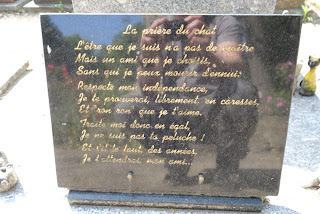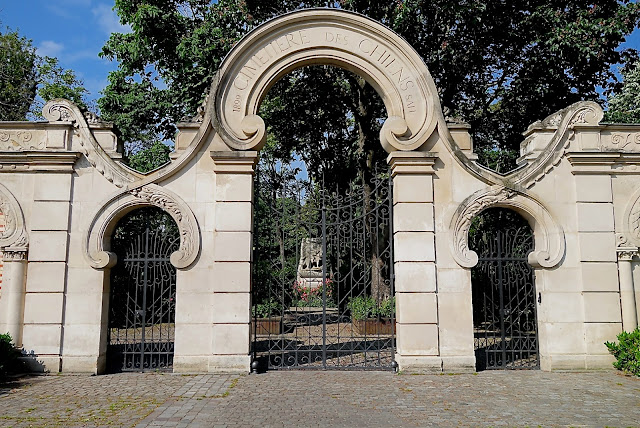Amsterdam and Paris - Day 8, Part 1 - The Cimitière des Chiens (or, I DO Wanna Be Buried in a Pet Sematary)
Day 8, Part 1 - The Cimitière des Chiens (or, I DO Wanna Be
Buried in a Pet Sematary)
Our eighth day in Paris started with a long train ride to
the Northwest of Paris, to a suburb called Asnière-sur-Seine, for what turned
out to be the highlight of the trip.
Paris is well known for her celebrated cemeteries, most notably the Père Lachaise, which is home to the graves of such luminaries as Oscar Wilde, Edith Piaf, and Jim Morrison. On my recent trip to Paris, I had another cemetery in my sights – the Cimitière des Chiens, the world’s oldest public pet cemetery.

The cemetery has a rich history. In
the 19th century, although animal welfare had been steadily
improving in Paris, the options for what to do with the remains of a deceased
pet were still crude and limited. More often than not, the remains
were tossed out with the household garbage, when they were not dumped into the
Seine or in the moats around the fortified city walls. However, on
June 21st, 1898, the Paris city government declared that dead pets
could no longer be discarded in the trash or dumped in the river. Deceased
pets had to be buried in hygienic graves that were located, at minimum, 100
meters from the nearest dwelling and in such a way that “the body will be
covered with a layer of earth to be at least a meter thick”.
At that time, the suburb of Asnière-sur-Siene, in the
northwest of Paris, was a Sunday destination reserved for Parisians in search
of greenery and distractions. This stretch of the Siene happened to face
L’Ile des Ravageurs (the Island of Destruction), a small island occupied only
by rag merchants who gathered old fabric, metal and other abandoned objects for
retail. Attorney Georges Harmois and journalist Marguerite Durand sought
to profit from the new law authorizing the internment of deceased animals by
conceiving, on May 2, 1899, the “Anonymous French Society of the Cemetery for
Dogs and other Domestic Animals”. On June 15, 1899, the society
purchased from the Baron of Bosmolet half of L’Ile des Ravageurs, which met the
requirement of being at least 100 meters from the nearest dwelling. The first
zoological necropolis of its kind, the cemetery was officially opened to the
public at the end of the summer of 1899.
Although its name translates to “Cemetery of Dogs”, the Cimetière des Chiens contains more than 40,000 animals, including cats, a racehorse, a lion, a monkey, and other domestic animals such as rabbits, hamsters, mice, birds, and fish. In fact, I’ve seen the cemetery referred to, in publications and websites, as the Cimetière des Chiens et Autres Animaux Domestiques, emphasizing the welcoming of other domestic animals. In the original plans for the cemetery, separate quarters designated for dogs, cats, birds and other species. However, when I visited, it was clear that these distinctions have not been enforced.
Among some of the famous animals you’ll find memorialized in
the cemetery are Barry, Moustache, and Rin Tin Tin. Barry is perhaps the
world’s most famous St. Bernard, although the truth about his life and heroism
is obscured by some well-intentioned exaggeration. In 1900, a
monument was erected just inside the cemetery near the entrance, celebrating
the glory of Barry. (left) The plaque on his monument says “Il sauva la vie à
40 personnes. Il fut tué par le 41 ème” - “He saved the lives of 40 persons. He
was killed by the 41st. According to legend, news had come
that a Swiss soldier was lost in the mountains. Barry was searching for
the soldier and picked up the scent. He stopped before a large bank of ice and
dug until he reached the soldier. He licked the soldier, as he was trained to
do. Startled awake, the soldier mistook Barry for a wolf and fatally
stabbed him with his bayonet. The truth is less exciting, I’m
afraid. Yes, he did save some 40 lives, but after 12 years of service he
was brought by a monk to Bern, Switzerland, so that he could live out the rest
of his life comfortably. He died in 1814 at the age of 14.
Barry is not actually buried in the cemetery. His body was preserved and
put on display at the Natural History Museum in Bern.
The last official monument to be inaugurated at the cemetery
was erected on March 11, 2006, in the memory of the dog Moustache, mascot of
the Grand Army between 1799 and 1811. Moustache was a French poodle born
in Normandy in 1799. The dog is said to have joined a grenadier regiment
at Caen. He accompanied the soldiers closely through the Italian Campaign
of the Revolutionary Wars. He is best known for alerting the regiment to
a surprise attack at the Battle of Marengo (during which he lost an ear), and
for discovering an Austrian spy at the Battle of Austerlitz. Moustache
was wounded pretty badly at Austerlitz, resulting in his leg being
amputated. For his bravery, he was awarded a medal by Marshal Jean
Lannes. He is later said to have accompanied a unit of dragoons to Spain
where he fought in the Peninsular War. He went on to see action in the Sierra
Morena, and later with a gunboat unit at the Battle of Badajoz, where he was
killed by a cannonball.
And then of course, there’s Rin Tin Tin, the canine star of
Hollywood in the 1920’s and ‘30’s. Rin Tin Tin was a French dog, rescued
from a bombed-out kennel in Lorraine by an American soldier during WWI and
taken to the U.S., where he found fame in some twenty-six Warner Brothers
films. When he died in 1932, it seemed fitting to return him to his
homeland.
Another testament to the bond between humans and animals is
a monument built in the memory of police dogs killed in the line of duty.
It was erected in 1912, and contains the bodies of several brave dogs,
including Dora, Papillon, and Léo. Pets that belonged to well-known
figures are also buried here, such as Camille Saint-Saëns, composer of the
classical musical suite The Carnival of the Animals.
Some of the graves are marked with just a simple plaque.
Many have rather elaborate headstones and engravings. A fair number are
adorned with statues, trinkets, and photos of the beloved pet. If you
want a great example of the power of simplicity, take a look at this one.
It contains the dog’s name, and a plastic case filled with tennis balls.
This dog obviously loved his tennis balls more than anything else, and it is
heartwarming to see this commemorated in such an understated yet powerful
manner.
Another favorite of mine was this engraved, photo-adorned tomb for Ramses. The engraving reads: For you, my Ramsès, an exceptional cat, and so nice. We lived with paws and hands united for 9 ½ years of love and togetherness, but with some suffering, too. How cruel and hard it is to bear your absence. May God help us. If your grave should be neglected, I will still be close to you forever in my heart – Your Mama. There are also separate short dedications to Reglisse, Omalay, Khaline, Fanny, and Bizou.
Having been in existence for over a century, the cemetery,
not surprisingly, has suffered the ravages of time and a final closing was
planned in 1987. However, the people who owned the graves, as well
as many admirers of the old cemetery mobilized into action. The
Mayor’s office of Asnières saved the cemetery by having it classified as a
landmark. By ministerial act of June 25, 1987, the county commission
registered the cemetery site as a landmark, in consideration of its
“picturesque, artistic, historic and legendary” value. In 2001, he
mayor’s office of Asnières-sur-Seine decided to undertake a restoration of the
cemetery entrance, and to spruce up the landscaping. The beautiful Art Nouveau
entrance, designed by architect Eugène Petit, was been restored, and the wooded
area permits grave owners and visitors to once again enjoy the timeless charm
of this special cemetery.
* Many thanks to my client (and cat lover) Jane Grenier, for
her French translational skills.
Here are several more photos I took that day. To see them all in my photo album, click here







































































Comments
Post a Comment